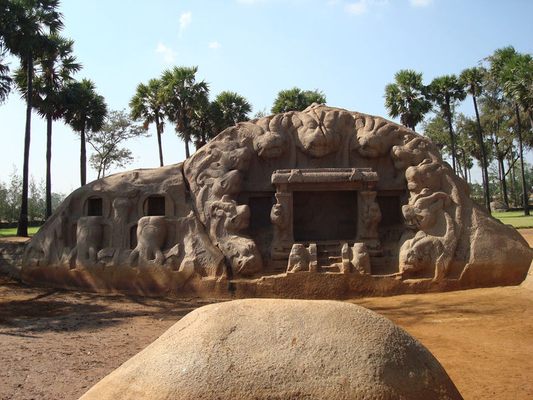About
There's no denying the appeal of picnicking where kings once stood, but throw in a seashore location and a multitude of carvings of tigers and a fierce Hindu goddess, and the people will flock.
Situated immediately along the shores of the Bay of Bengal, flanked by swaing casuarina trees, Tiger Cave has long been a favored recreation spot among locals willing to make the five-kilometer trek from Mahabalipuram to the strangely idyllic location just out of town.
In what may prove either to be a disappointment to some or reassurance to others: there are no real, live tigers at Tiger Cave. The site earned its name from its crown of 11 tiger-esque heads carved around the entrance to its gaping maw. In truth, scholars believe the images are more likely that of a mythological animal called a "yeli," which is more like a cross between a lion and a tiger. Aside from the appeal of picnicking in the presence of ancient holy cats of the sea, one of Tiger Cave's most popular features is actually a carving that depicts the Goddess Durga mounted atop one of these tigers (or yeli).
There's some debate as to whether Tiger Cave was built by Narasimhavarman I in the 7th century or Pallava King Rajasimha in the 8th century CE, but archaeologists are fairly certain its purpose was once that of a portico from which the ruler either gave audience or observed festivities.
Though the region itself is known for its proliferation of temples carved from rocks, few have the accessibility and strangely lithe spirit of Tiger Cave. Less frequently visited is the rock cut cave temple with a Shiva Linga and a Nandi at a corner of the Tiger's Cave complex. Regardless, the secrets of Tiger Cave are continuously unfolding; take, for example, in 2005, when an overlooked inscription in the rocks led to a discovery and subsequent excavation of the nearby Subrahmanya Temple.
The park's grounds are maintained by the Archaeological Survey of India, making Tiger Cave and the surrounding temples a free, public space. Situated among lush greenery and fresh breezes, this alone constitutes a perfect day of leisure along the water, even were the temples and looming caves to be removed from the equation. A handful of food and drink stands encircling the area, offering perfectly light refreshments like tender coconut cut on demand, leaving visitors only to want for except explanations of the cave's ancient mysteries – which would ruin half the temples' glory and wonder anyway.
Related Tags
Delhi and Rajasthan: Colors of India
Discover Colorful Rajasthan: From Delhi to Jaipur and Beyond.
Book NowPublished
November 30, 2015
Sources
- http://www.destinationinfinity.org/2012/12/31/tiger-caves-a-tourist-destination-5-km-before-mahabalipuram-ecr-chennai/
- http://www.thehindu.com/todays-paper/tp-national/tp-tamilnadu/visit-tigers-cave-for-a-quiet-weekend-getaway/article1778553.ece
- https://www.ixigo.com/tigers-cave-mahabalipuram-india-ne-1701043































